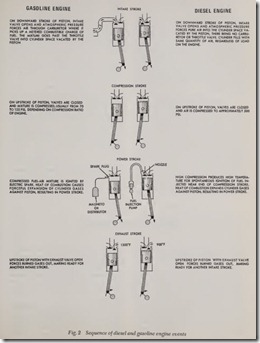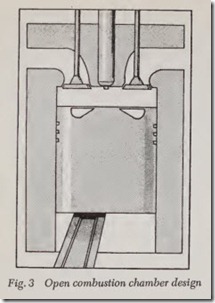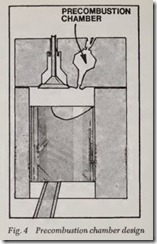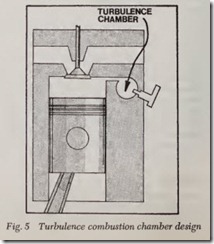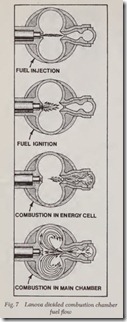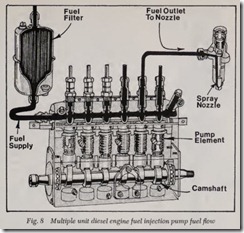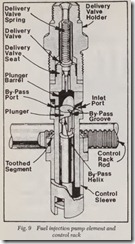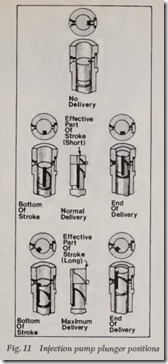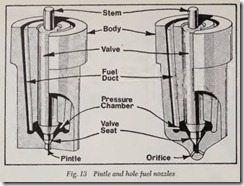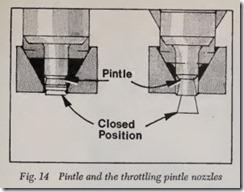The diesel engine bears the name of Dr. Ru dolph Diesel, a German engineer. He is credited with constructing, in 1897, the first successful die sel engine using liquid fuel. His objective was an engine with greater fuel economy than the steam engine, which used only a small percentage of the energy contained in the coal burned under its boilers. Dr. Diesel originally planned to use pul verized coal as fuel, but his first experimental engine in 1893 was a failure. Mter a second engine also failed, he changed his plan and used liquid fuel. The engine then proved successful.
DIESEL ENGINE COMPARED TO THE
GASOLINE ENGINE
General Mechanical Construction
The diesel engine is mechanically similar to the gasoline engine but is somewhat heavier in con struction. Both engine types utilize air, fuel, com pression, and ignition. Intake, compression, power and exhaust occur in the same sequence; arrange ments of pistons, connecting rods, and crankshafts are similar. Both are internal combustion engines; that is, they extract energy from a fuel-air mixture by burning the mixture inside the engine.
Fuel Intake and Ignition of Fuel-Air Mixture
In principles of operation, the main difference between gasoline and diesel engines, Figs. 1and 2, is the two different methods of introducing the fuel into the cylinder and of igniting the fuel-air mixture. Fuel and air are mixed together before they enter the cylinder of a gasoline engine, then the mixture is compressed by the upstroke of the piston and is ignited within the cylinder by a spark plug. (Devices other than spark plugs, such as “firing tubes,” are sometimes utilized.) Air alone enters the cylinder of a diesel engine; the air is compressed by the upstroke of the piston and the diesel fuel is injected into the combustion chamber near the top of the upstroke ( compres sion stroke). The air becomes greatly heated dur ing compression and the diesel fuel ignites and burns as it is injected into the heated air. No spark plug is used in the diesel engine; ignition is by contact of the fuel with the heated air, although “glow plugs” are used in some models of diesel engines to assist only in starting the engine. Pres sure developed by the compression stroke is much greater in the diesel engine, in which pressures as high as 500 psi are common. For each pound of pressure exerted on the air, there will be a tem perature increase of about 2° F. At the top of the compression stroke (when pressure is highest), the temperature in the chamber will be about 1,000° F. This heat ignites the fuel almost as soon as it is injected into the cylinder, and the piston, actuated by the expansion of burning gases, then moves down on the power stroke. In a gasoline engine, the heat from compression is not enough to ignite the fuel-air mixture and a spark plug is therefore necessary.
Control of Speed and Power
The speed and the power output of diesel en gines are controlled by the quantity of fuel in jected into the cylinder. This is opposed to the common gasoline engine, which controls speed and power output by limiting the amount of air ad mitted into the carburetor. Therefore the differ ence between the diesel and the gasoline engine is that the diesel engine controls the quantity of fuel, whereas the gasoline engine regulates the quantity of air. In the diesel engine, a varying amount of fuel is mixed with a constant amount of com pressed air inside the cylinder. A full charge of air enters the cylinder on each intake stroke. Because the quantity of air is constant, the amount of fuel injected determines power output and speed of engine. As long as the amount of fuel injected is below the maximum established by the manu facturer in designing the engine, there is always nough air in the cylinder for complete combus tion. The gasoline engine air intake is controlled by the carburetor. The amount of air and its ve locity, in turn, control the quantity of fuel that is picked up and mixed with air to be admitted into the cylinder. The amount of mixture available for combustion determines power output and speed of engine. It is apparent, therefore, that the con trolling factor is the quantity and velocity of air passing through the carburetor.
Combustion Processes
In the diesel engine, there is continuous com bustion during the entire length of the power stroke; pressure resulting from combustion remains approximately constant throughout the stroke. In the gasoline engine, however, combustion is com pleted while the piston is at the upper part of its travel. This means that the volume of the mixture stays about the same during most of the combus tion process. When the piston moves down and the volume increases, there is little additional com bustion to maintain pressure. Because of these facts, the cycle of the gasoline engine is often re ferred to as having constant-volume combustion while the diesel cycle is said to have constant pressure combustion.
Diesel Fuel System
CHARACTERISTICS OF DIESEL COMBUSTION
Diesel Fuels
The fuels used in modern high-speed diesel engines are a product of the petroleum refining process. They are heavier than gasoline because they are obtained from the leftovers, or residue, of the crude oil after the more volatile fuels such as gasoline and kerosene have been removed. The large, slow-running diesel engines used in sta tionary or marine installations will burn almost any grade of heavy fuel oil, but the high-speed diesel engines used in automotive installations require a fuel oil as light as kerosene. Although diesel fuel is different from gasoline, its specifica tion requirements are just as exacting as those of gasoline. Of the various properties to be consid ered in selecting a fuel for diesel engines, the most important are cleanliness, viscosity, and ignition quality.
Cleanliness
Probably the most necessary property of a diesel fuel is cleanliness. The fuel should not contain more than a trace of foreign substance; otherwise, fuel pump and injector difficulties will occur. Die sel fueL because it is heavier and more viscous than gasoline, will hold dirt in suspension for long er periods of time. Therefore, every precaution must be taken to keep dirt out of the fuel system or to eliminate it before it reaches the pumps. Water is more objectionable in diesel fuels than it is in gasoline because it will cause ragged opera tion and corrode the fuel system. The least amount of corrosion of the accurately machined surfaces in the injection equipment will cause it to become inoperative.
Viscosity
The viscosity of an oil is an indication of its resistance to flow. The higher the viscosity, the greater the resistance to flow. The viscosity of a diesel fuel must be sufficiently low to flow freely at the lowest temperatures encountered, but it must also be high enough to properly lubricate the closely fitted pump and injector plungers. It must also be sufficiently viscous to avoid leakage at the pump plungers and dribbling at the injectors. The viscosity of a fuel also determines the size of the fuel-spray droplets which, in turn, govern the atomization and penetration qualities of the spray.
Ignition Quality
The ignition quality of a diesel fuel is its ability to ignite spontaneously under the conditions exist ing in the engine cylinder. The spontaneous ignition point of a fuel is a function of tempera ture, pressure, and time. Since it would be difficult to artificially reproduce these factors as they exist in an engine cylinder, the best apparatus for mea suring the ignition quality of a fuel is an actual diesel cylinder running under controlled operating conditions. The yardstick used for measuring the ignition quality of diesel fuels is the cetane number scale. The cetane number of a fuel is ob tained by comparing the operation of the unknown fuel in a special test engine with the operation of a known reference fuel in the same engine. The reference fuel is a mixture of alpha-methyl-naph thalene, which will hardly ignite when used alone, and cetane, which will readily ignite at tempera tures and pressures obtained in a diesel cylinder. The cetane number indicates the percent of cetane in a reference fuel which will just match the ig nition properties of the fuel being tested.
Knocking
It has been observed that diesel engines knock , particularly at light loads. This knock is believed to be due to the rapid burning of the charge of fuel accumulated during the delay period be tween the time of injection and ignition. When the fuel is injected, it must first vaporize, then superheat until it finally reaches the spontaneous ignition temperature under the proper conditions to start combustion. Time is required for sufficient fuel molecules to go through this cycle to permit ignition. This time is called ignition lag or ignition delay. During this same time, other portions of the fuel are being injected and are going through the same phases but behind the igniting portion; therefore, as the flame spreads from the point of ignition, appreciable portions of the charge reach their spontaneous-ignition temperatures at prac tically the same instant. This rapid burning causes a very rapid increase in pressure, which is accom panied by a distinct and audible knock. Increas ing the compression ratio in the diesel engine will decrease the ignition lag and thereby decrease the tendency to knock. The reverse is true in a gaso line engine. Increasing the compression ratio in a gasoline engine leads to pre-ignition and, in addition, tends to make detonation worse. Knock ing in the diesel engine is affected by a large num ber of factors besides compression ratio. The type of combustion chamber, air flow within the cham ber, the type of nozzle, the injection pressure con ditions, the fuel temperature, and the air tem perature are all factors, as are the characteristics of the fuel itself. For these reasons, more can be done in the design of a diesel engine to make it operate smoothly without detonation than is pos sible with the gasoline engine.
Combustion Chamber Design
The fuel injected into the combustion space of a diesel engine must be thoroughly mixed with the compressed air and distributed as evenly as possible throughout the chamber if the engine is to function under the principles discussed previ ously. None of the liquid fuel should strike the chamber walls. It is essential that the shape of the combustion chamber and the characteristics of the injected fuel spray be closely related. There are many types of combustion chambers in use today, but they are all designed to produce one effect, to bring sufficient air into contact with the injected fuel to provide complete combustion at a constant rate. All modem combustion chamber designs may be classified under one of the following: 1. Open ,2. Precombustion, 3. Turbulence, 4. Divided cham bers. Designs which fall under two or more head ings will be covered under the heading which is tl1e most applicable.
Open Chamber
The open chamber, Fig. 3, is the simplest form of chamber, but its use is limited to slow-speed engines. The fuel is injected directly into the com bustion space at the top of the cylinder. The com bustion space, formed by the top of the piston and the cylinder head, is shaped to provide a swirling action of the air as the piston comes up on the compression stroke. There are no special cells, pockets, or passages to aid the mixing of fuel and air. This type of chamber requires higher injection pressures and a greater degree of fuel atomization than is required by the other types to obtain the same degree of mixing.
Precombustion Chamber
The precombustion chamber, Fig. 4, is an aux iliary chamber at the top of the cylinder. It is connected to the clearance volume above the pis ton through a restricted throat or passage. The precombustion chamber conditions the fuel for final combustion in the cylinder and distributes the fuel throughout the air in the cylinder in such a way that complete, clean burning of all the fuel is assured. On the compression stroke of the en gine, air is forced into the precombustion chamber and, since the air is compressed , it becomes very hot. Thus, at the beginning of injection this small chamber contains a definite volume of air. Consequently, combustion of the fuel actually starts in the precombustion chamber, since the fuel is injected into the chamber. Only a small part of the fuel is burned in this chamber because there is only a limited amount of oxygen present in this small chamber with which it can unite. The small predetermined amount that burns creates heat which, in tum, creates high pressure within the precombustion chamber; as injection continues, this high pressure forces the fuel at great velocity into the cylinder. There is ample oxygen present in the cylinder to bum all the fuel completely, re gardless of the speed or load under which the engine is operating. Fuel injection pressures need not be as high with this type of chamber as in the open type. A coarser spray is satisfactory because the function of the chamber is to vaporize the fuel further before it enters the cylinder.
Turbulence Chamber
The turbulence chamber, Fig. 5, is similar in appearance to the precombustion chamber, but its function is different. There is very little clear ance between the top of the piston and the head, so that a high percentage of the air between the piston and the cylinder head is forced into the turbulence chamber during the compression stroke. The chamber is usually spherical, and the opening through which the air must pass becomes smaller as the piston reaches the top of the stroke, thereby increasing the velocity of the air in the chamber. This turbulence speed is approximately 50 times crankshaft speed. The fuel injection is timed to occur when the turbulence in the cham ber is the greatest. This insures a thorough mixing of the fuel and the air, with the result that the greater part of combustion takes place in the tur bulence chamber itself. The pressure created by the expansion of the burning gases is the force that drives the piston downward on the power stroke.
Divided Chamber
The divided chamber, or combination precom bustion chamber, probably is better known by the trade name, Lanova combustion chamber. Like the open chamber combustion system, the main vol ume of air remains and the principal combustion takes place in the main combustion chamber; but unlike the open chamber combustion system, the combustion is controlled. Like the turbulence chamber type, the Lanova system depends on a high degree of turbulence to promote thorough mixing and distribution of the fuel and air; but unlike the turbulence-chamber this entails no in crease in pumping losses. Ninety percent of the combustion chamber is directly in the path of the in-and-out movement of the valves. The turbu lence in the Lanova system is dependent upon thermal expansion and not on engine speed, unlike the other systems which depend on engine speed.
Primarily, the Lanova system involves the com bination of the figure-S-shaped combustion cham ber situated centrally over the piston, and a small air chamber known as the energy cell, Figs. 6 and
7. In its latest development, this energy cell is comprised of two separate chambers, an inner and an outer. The inner chamber, which is the smaller of the two, opens into the narrow throat between the two lobes of the main combustion chamber through a funnel-shaped venturi passage. The larger outer chamber communicates with the inner one through a second venturi. Directly op posite the energy cell is the injection nozzle.
During the compression stroke, about 10 per cent of the total compressed volume passes into the energy cell, the remainder staying in the fig-ure-8-shaped combustion chamber. The fuel is in jected in the form of a pencil stream which passes directly across the narrow throat of the combus tion chamber, most of it penetrating the energy cell. A small portion of the boundary layer fol lows the curvature of the combustion chamber lobes and swirls into vortexes within them, thus, indicating a weak combustion. The fuel entering the energy cell is trapped, for the most part, in the small outer cell, but a small part passes into the larger outer cell where it meets a sufficient quantity of superheated air to explode violently.
This explosion produces an extremely rapid rise to high pressure within the steel energy cell, which blows the main body of the fuel lying in the inner cell back into the main combustion chamber, where it meets the main body of air. Here, because of the shape of the chamber, it swirls around at an exceedingly high rate of turbulence, thus burn ing continuously as it issues from the energy cell. The blow-back of fuel into the combustion cham ber is controlled by the restriction of the two venturi connecting the energy cells, consuming an appreciable period of time and producing a pro longed and smooth combustion in which the rate of pressure rise on the piston is gradual.
INJECTION SYSTEMS
Fuel Injection Principles
Methods of Injection
There are two methods of injecting the fuel against the air pressure in the cylinder of a diesel engine: 1. air injection, where a blast of air from an external source forces a measured amount of fuel into the cylinder 2. solid injection, where the fuel is forced into the cylinder by a direct pressure on the fuel itself. The following coverage will be limited to those systems utilizing solid injection, since the air injectiod system has been proved im practical for automotive installations.
Fuel Atomization and Penetration
The fuel spray entering the combustion cham ber must conform to the shape of the chamber so that the fuel particles will be well distributed and thoroughly mixed with the air. The shape of the spray is determined by the degree of atomization and penetration produced by the orifice through which the fuel enters the chamber. Atomization is the term used to denote the size of the drops into which the fuel is broken, whereas Penetration is the distance from the orifice which an oil drop attains at a given phase in the injection period. Ba:sically, the penetration of a spray depends on the length of the nozzle orifice, the diameter of the orifice outlet, the viscosity of the fuel, and the pressure on the fuel. Penetration increases with the increasing ratio of the length of the orifice to its diameter; atomization, however, (inversely pro portional) is increased by decreasing the ratio of the length of an ori£ce to its diameter. Because of the relationship between penetration and atomi zation, a compromise is necessary if uniform fuel distribution is to be obtained. The amount of pres sure required for efficient injection is dependent on the pressure of the air in the combustion cham ber, the size of the orifice, the shape of the com bustion chamber, and the amount of turbulence produced in the combustion space.
Function of Injection System
It is impossible to cover the operation and con struction of the many types of modern injection systems in this text. However, the operation of a few of the more common systems will be dis cussed. Emphasis will be placed on functional op eration rather than mechanical details. The func tion of each system is to meter the fuel accurately, deliver equal amounts of fuel to all cylinders at a pressure high enough to insure atomization, and control the start, rate and duration of injection. If this three-fold function is kept in mind, the opera tion of the various systems will be more easily understood.
Multiple-Unit Injection Pump System
General Operation
In this system each cylinder has an individual injection pump which meters the fuel and delivers it under high pressure to the spray nozzles which lead into the combustion chambers. The pumps are mounted in a common housing, are operated by a common camshaft, and utilize the same con trol mechanism to insure an equal amount of fuel in each cylinder at the proper time. The flow of fuel in a typical multiple-unit injection pump sys tem is shown in Fig. 8. Diesel fuel oil flows from the supply tank through a fuel filter to the fuel supply pump. The fuel supply pump forces the fuel through an additional filter to the injection pumps. The fuel injection pumps force a measured amount of fuel through high-pressure lines to the spray nozzles in the combustion chambers. Sur plus fuel flows from the injection pumps through a check valve on the common housing and is re turned to the fuel supply tank.
Fuel Injection Pumps
A phantom cross-sectional view of a typical multiple-unit injection pump, is shown in Fig. 8.This pump is mounted on the engine in such a manner as to permit it to be driven by the engine. The pump camshaft, near the bottom of the hous ing, is carried on ball bearings. The cam lobes -cause the upward movement of .the plungers, and springs produce the downward motion. The cams are arranged to actuate the individual pumps in the same sequence as the firing order of the engine to eliminate the necessity for crossing lines leading from the pumps to the spray nozzles. On the 4-stroke-cycle engine, the injection pump is driven at one-half engine speed.
The individual pumps are the lapped-plunger constant-stroke metering bypass type. The quan tity of fuel delivered to the spray nozzle is regu lated by the time the plunger covers the bypass port. The plunger stroke remains constant at all loads. The injection must be timed to occur as demanded by the requirements of the engine. Vol umetric control is effected by rotating the plunger. Two ports lead to the plunger barrel, Figs. 9 and 10, one of the ports is the inlet port and the other is the bypass port. The plunger has a groove around its circumference, which has a circular lower edge and helical upper edge. The space thus formed with this alignment is interconnected with the top face of the plunger through a vertical slot. Hence, any fuel above the plunger will flow down the vertical slot and fill the helical space. At the lower end of the plunger are two lugs which fit in cor responding slots in the bottom of an outer sleeve fitted around the pump barrel. The upper portion of the sleeve is fastened to a gear segment which meshes with a horizontal toothed rack. Any movement of the rack rotates the outer sleeve and plunger relative to the bypass port in the station ary pump barrel.
Fuel from the sump rushes into the barrel as soon as the upper edge of the plunger opens the two opposite ports in the barrel. Tills action begins during the downward stroke of the plunger, and the ports remain open until the plunger starts moving upward. After the plunger covers the ports on its upward stroke, the pressure exerted on the fuel causes the spring-loaded delivery valve to lift off its seat, thereby, permitting the fuel to dis charge into the tubing which leads to the spray nozzle. The delivery of the fuel ceases as soon as the helix on the plunger uncovers the bypass port in the barrel. At this instant, the pressure chamber is interconnected with the sump by way of the vertical groove and the helix on the plunger. This alignment thus relieves the pressure in the barrel.
The delivery valve is quickly returned to its seat by the combined action of its spring and the great difference in pressure that exists between the bar rel and the high-pressure line. In returning to its seat, the delivery valve performs a double func tion . It prevents excessive draining of the fuel from the high-pressure line, 2. It relieves the pres sure in the high-pressure line. This pressure relief is accomplished by an accurately lapped displace ment piston on the delivery valve. Before the de livery valve actually reseats, it reduces the pres sure in the high-pressure line by increasing the volume by a quantity equal to the volume of the displacement piston.
For maximum delivery, the plunger is positioned in the barrel so that it will nearly complete its stroke before the helix indexes with the bypass port, Fig. 11. For zero delivery, the plunger is turned in its barrel until the vertical slot registers with the bypass port, Fig. 11. In this position, the pressure chamber is connected with the sump dur ing the entire stroke of the plunger. Any position between no fuel to maximum fuel delivery can be obtained by moving the control rack in or out, as the movement of the rack causes the plunger to rotate a proportionate amount. The same rack con trols the position of all the plungers simultane ously, thereby insuring the injection of equal amounts of fuel in each cylinder of the engine.
Spray Nozzles and Nozzle Holders General
For proper engine performance, the fuel oil must be injected into the combustion space in a definite spray form. This is accomplished by the spray nozzle, which is held in the co1Tect position in the cylinder head by the nozzle holder. The type of unit, Fig. 12, is most commonly used with the multiple-unit injection pump.
Operation
The fuel delivered by the injection pump flows through the high-pressure line and enters the nozzle-holder inlet stud. Then it passes through the edge filter, flows through the ducts in the holder and nozzle body, and flows down into the pressure chamber of the spray nozzle above the valve seat. There, the pressure of the fuel oil acts on the differential area of the nozzle valve. At the moment when the pressure of the fuel exceeds the pr essure exerted by the adjusting spring, the noz zle valve is lifted off its seat and the fuel is forced through the orifices and sprayed into the combus tion chamber of the engine. The nozzle valve re turns to its seat after the injection pump has ceased to deliver fuel. The hydraulic opening pres sure of the spray nozzle may vary from 1,000 to 4,000 psi, depending on engine combustion-cham ber requirements. A crertain amount of seepage of fuel between the lapped , surfaces of the nozzle valve and its body is necessary for lubrication. This leakage oil accumulates around the spindle and in the spring compartm ent, from which it drains through the leakoff connection provided for that purpo se.
Spray Nozzles
Because of the widely differing requirements in the shapes of the fuel spray for various combus tion chamber designs, and because of the wide range in engine power demands, there is a large variety of nozzles u sed with multiple-unit injection pump system s. Essentially, there are two basic groups : pintle nozzles and hole nozzles, Fig. 13. Pintle nozzles are generally used in engines having precombustion, turbulence, or divided chambers, whereas the hole nozzles are generally used with open combustion chamber designs.
Pintle Nozzles
In pintle nozzles, Fig. 14, the nozzle valve car ries an extension at its lower end in the form of a pin (pintle) which protrudes through the hole in the nozzle bottom. This requires the injected fuel to pass through an annular orifice, producing a hollow cone-shaped spray, the nominal included angle of which may be from 0° to 60°, depending on the combustion system requirement. The pro jection of the pintle through the nozzle orifice in duces a self-cleaning effect, reducing the accumu lation of carbon at this point.
A specific type of pintle nozzle extensively used in small-bore, high-speed diesel engines is the throttling nozzle. It differs from the standard pintle nozzle in that the pintle projects from the nozzle body for a much greater distance, and the orifice in the bottom of the nozzle body is much longer, Fig. 14. The outstanding feature of the throttling nozzle is its control of the rate at which fuel is injected into the combustion chamber. The pintle extends through the nozzle orifice when no fuel is being injected, and hydraulic pressure from the injection pump causes the pintle to rise for fuel delivery. At the beginning of the injection period, only a small quantity of fuel is injected into the chamber because the straight section of the pintle is in the nozzle orifice. The volume of the fuel spray is then progressively increased as the pintle is lifted higher. When the straight sec tion of the pintle moves out of the orifice the tapered tip of the pintle in the orifice provides a larger opening for the flow of fuel. Another type of throttling nozzle has its pintle flush with the nozzle-body tip for no fuel delivery and extended this type of nozzle, fuel under high pressure from the injection pump acts on the seat area of the pintle, forcing it outward against a preloaded spring. This spring, through its action on a spring hanger, also returns the pintle to its seat, sealing the nozzle against further injections or dribble when the line pressure is relieved at the pump. When the pintle moves outward, due to fuel pres sure, an increasingly larger orifice area is opened around the flow angle of the pintle.

